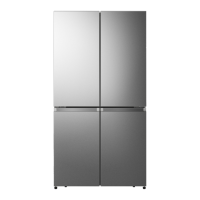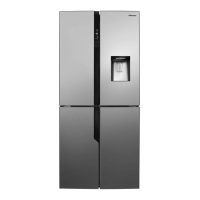Why is my Hisense RQ758N4SAI1 too cold?
- MMegan EvansSep 7, 2025
If your Hisense Refrigerator or freezer is too cold, adjust the temperature in the compartment to the next warmer setting and allow 24 hours for the temperature to adjust.

Why is my Hisense RQ758N4SAI1 too cold?
If your Hisense Refrigerator or freezer is too cold, adjust the temperature in the compartment to the next warmer setting and allow 24 hours for the temperature to adjust.
Why is my Hisense RQ758N4SAI1 not running?
If your Hisense Refrigerator does not run, plug it into a grounded 3 prong outlet. Check if the breaker is tripped or turned off, or if a fuse is blown, and reset/turn on the breaker or replace the fuse. If the refrigerator is in defrost mode, wait for the defrost cycle to end and the cooling system to restart.
| Child lock | No |
|---|---|
| Control type | Touch |
| Display type | LED |
| Door assembly | Door-on-door |
| Product color | Stainless steel |
| Product design | French door |
| Built-in display | Yes |
| Housing material | Metal |
| Shelves material | Glass |
| Custom panel-ready | - |
| Appliance placement | Freestanding |
| Fridge net capacity | 393 L |
| Fridge door balconies | 6 |
| Number of vegetable drawers | 4 |
| Fridge number of shelves/baskets | 3 |
| Noise level | 43 dB |
| Climate class | N-T |
| Cooling system | Dynamic (fan-assisted) |
| Total net capacity | 609 L |
| Total gross capacity | 621 L |
| Minimum operating temperature | 16 °C |
| Star rating | 4* |
| Freezer position | Bottom-placed |
| Freezing capacity | 6 kg/24h |
| Freezer net capacity | 216 L |
| Freezer number of doors | 2 |
| Storage time during power failure | 16 h |
| Connected load | - W |
| Energy efficiency scale | A to G |
| Annual energy consumption | 399 kWh |
| Package depth | 778 mm |
| Package width | 968 mm |
| Package height | 1901 mm |
| Package weight | 137000 g |
| Depth | 725 mm |
|---|---|
| Width | 912 mm |
| Height | 1785 mm |
| Weight | 128000 g |
General safety and warning information for appliance usage, including hazard symbols.
Safety guidelines for children and individuals with reduced capabilities.
Essential safety precautions for general appliance operation and intended use.
Information on LED light replacement and safety precautions regarding refrigerant.
Crucial electrical safety guidelines and recommended practices for daily appliance usage.
Guidelines for safely disposing of old refrigerators and refrigerants.
Identification and description of various refrigerator components.
Guidelines for selecting an appropriate installation location and required clearances.
External dimensions and physical characteristics of the refrigerator.
Requirements for adequate air circulation around the appliance for efficient operation.
Specifications and requirements for electrical connections, including grounding.
Steps for safely unpacking the refrigerator and cleaning its interior before use.
Steps to finalize installation, including moving to location and leveling the unit.
Guidance on opening and closing refrigerator doors correctly, including mullion function.
Instructions for aligning the refrigerator doors using gaskets.
Instructions for powering the appliance on/off and setting compartment temperatures.
Guide to setting temperatures for Fridge, Freezer, and My Fresh Choice compartments.
Explanation and usage of the Super Cool and Holiday modes.
Information about the door open alarm system and its function.
Instructions for adjusting shelves, removing drawers, and managing door bins.
Care for glass shelves and general advice for using the refrigerator.
Guidelines to prevent food contamination and maintain hygiene within the appliance.
Guide to storing different types of food in various compartments based on temperature.
Detailed instructions for cleaning the refrigerator's interior, exterior, and door seals.
Information regarding the refrigerator's LED lighting system and replacement.
Instructions for managing the refrigerator during vacation periods.
Steps for preparing, moving, and reinstalling the refrigerator.
Solutions for refrigerator not operating and frequent compressor cycles.
Troubleshooting for odors, non-functional lights, and door closure issues.
Diagnosing vibration, rattling sounds, and understanding normal operating noises.
Solutions for when the refrigerator or freezer is too warm or too cold.
Addressing moisture on surfaces and frost/ice on frozen food.
How to prevent food from freezing unintentionally in the refrigerator compartment.











